Analysis of Leadership and Management Strategies at Starbucks
VerifiedAdded on 2021/04/23
|7
|3239
|223
Report
AI Summary
This report provides a detailed analysis of leadership and management practices within Starbucks. It begins by examining different leadership styles, including situational, systems, and contingency approaches, and evaluates their strengths and weaknesses in the context of Starbucks' operations. The report delves into the application of these leadership theories to the company's strategic objectives, particularly in response to competitive pressures and operational challenges. Furthermore, the report explores key approaches to operations management, such as Total Quality Management (TQM), lean production, and process improvement, and discusses how leaders and managers can leverage these strategies to enhance operational efficiencies and meet business objectives. The influence of environmental factors on Starbucks' operational management and decision-making processes is also considered, highlighting the importance of adapting to external influences to maintain a competitive edge.
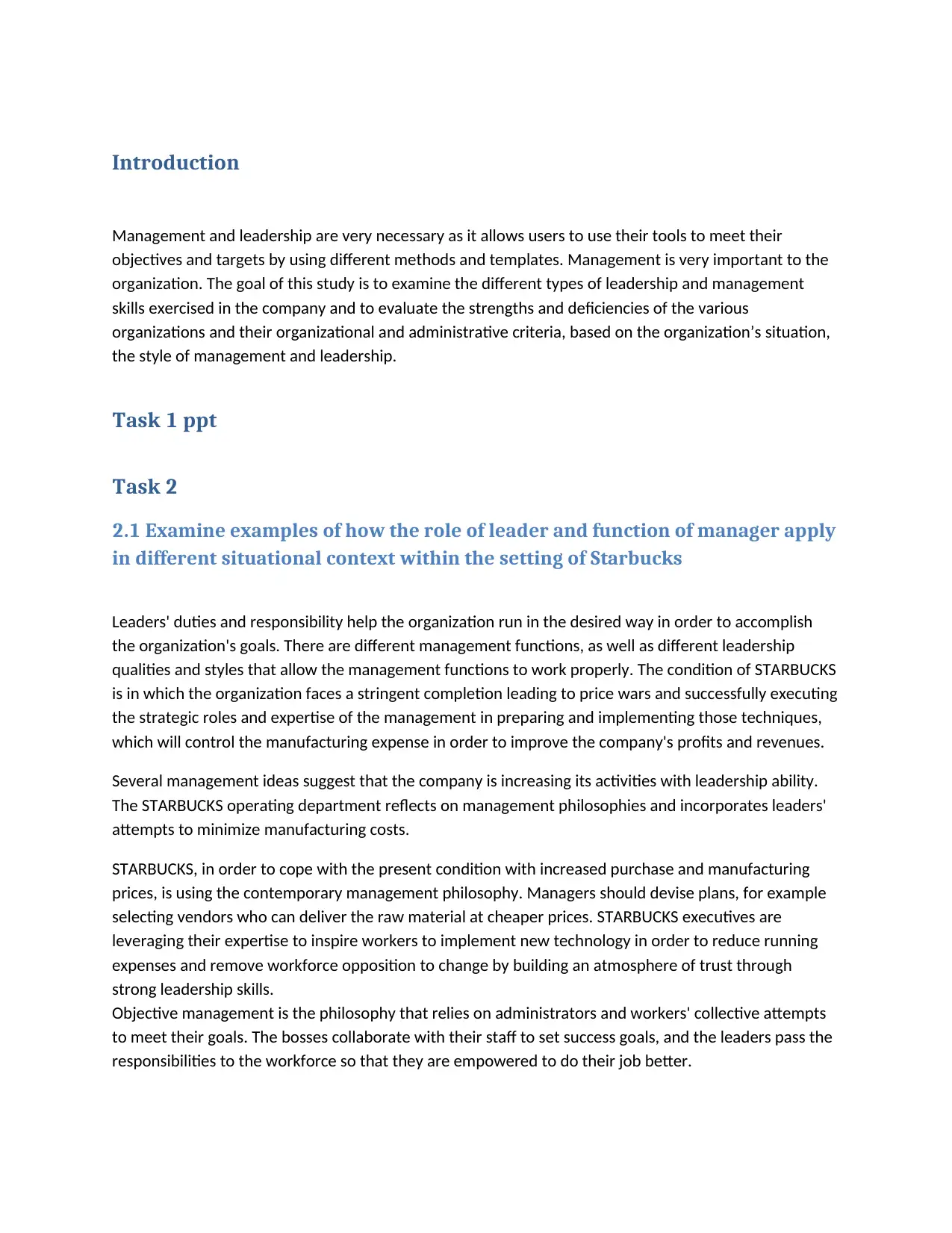
Introduction
Management and leadership are very necessary as it allows users to use their tools to meet their
objectives and targets by using different methods and templates. Management is very important to the
organization. The goal of this study is to examine the different types of leadership and management
skills exercised in the company and to evaluate the strengths and deficiencies of the various
organizations and their organizational and administrative criteria, based on the organization’s situation,
the style of management and leadership.
Task 1 ppt
Task 2
2.1 Examine examples of how the role of leader and function of manager apply
in different situational context within the setting of Starbucks
Leaders' duties and responsibility help the organization run in the desired way in order to accomplish
the organization's goals. There are different management functions, as well as different leadership
qualities and styles that allow the management functions to work properly. The condition of STARBUCKS
is in which the organization faces a stringent completion leading to price wars and successfully executing
the strategic roles and expertise of the management in preparing and implementing those techniques,
which will control the manufacturing expense in order to improve the company's profits and revenues.
Several management ideas suggest that the company is increasing its activities with leadership ability.
The STARBUCKS operating department reflects on management philosophies and incorporates leaders'
attempts to minimize manufacturing costs.
STARBUCKS, in order to cope with the present condition with increased purchase and manufacturing
prices, is using the contemporary management philosophy. Managers should devise plans, for example
selecting vendors who can deliver the raw material at cheaper prices. STARBUCKS executives are
leveraging their expertise to inspire workers to implement new technology in order to reduce running
expenses and remove workforce opposition to change by building an atmosphere of trust through
strong leadership skills.
Objective management is the philosophy that relies on administrators and workers' collective attempts
to meet their goals. The bosses collaborate with their staff to set success goals, and the leaders pass the
responsibilities to the workforce so that they are empowered to do their job better.
Management and leadership are very necessary as it allows users to use their tools to meet their
objectives and targets by using different methods and templates. Management is very important to the
organization. The goal of this study is to examine the different types of leadership and management
skills exercised in the company and to evaluate the strengths and deficiencies of the various
organizations and their organizational and administrative criteria, based on the organization’s situation,
the style of management and leadership.
Task 1 ppt
Task 2
2.1 Examine examples of how the role of leader and function of manager apply
in different situational context within the setting of Starbucks
Leaders' duties and responsibility help the organization run in the desired way in order to accomplish
the organization's goals. There are different management functions, as well as different leadership
qualities and styles that allow the management functions to work properly. The condition of STARBUCKS
is in which the organization faces a stringent completion leading to price wars and successfully executing
the strategic roles and expertise of the management in preparing and implementing those techniques,
which will control the manufacturing expense in order to improve the company's profits and revenues.
Several management ideas suggest that the company is increasing its activities with leadership ability.
The STARBUCKS operating department reflects on management philosophies and incorporates leaders'
attempts to minimize manufacturing costs.
STARBUCKS, in order to cope with the present condition with increased purchase and manufacturing
prices, is using the contemporary management philosophy. Managers should devise plans, for example
selecting vendors who can deliver the raw material at cheaper prices. STARBUCKS executives are
leveraging their expertise to inspire workers to implement new technology in order to reduce running
expenses and remove workforce opposition to change by building an atmosphere of trust through
strong leadership skills.
Objective management is the philosophy that relies on administrators and workers' collective attempts
to meet their goals. The bosses collaborate with their staff to set success goals, and the leaders pass the
responsibilities to the workforce so that they are empowered to do their job better.
Paraphrase This Document
Need a fresh take? Get an instant paraphrase of this document with our AI Paraphraser
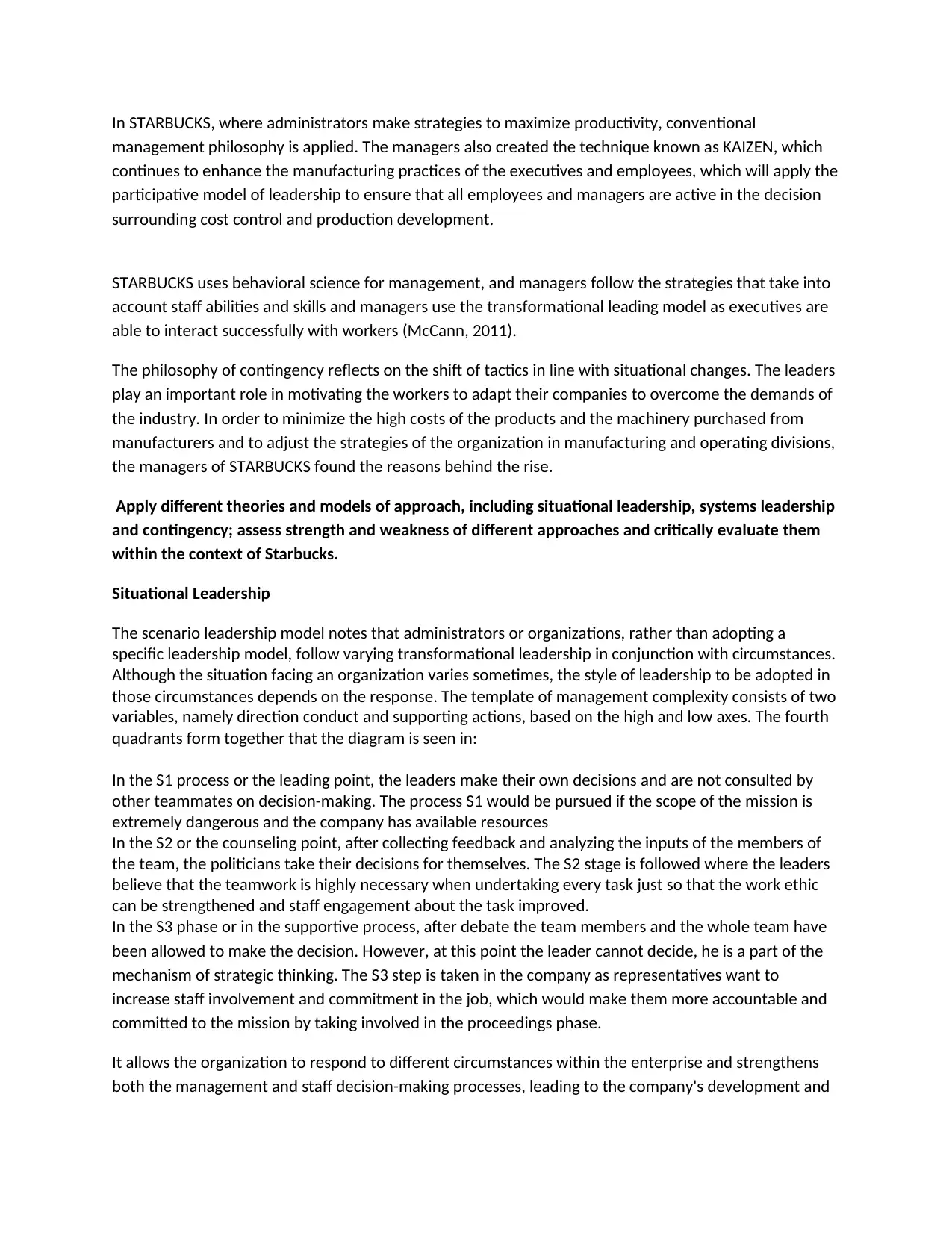
In STARBUCKS, where administrators make strategies to maximize productivity, conventional
management philosophy is applied. The managers also created the technique known as KAIZEN, which
continues to enhance the manufacturing practices of the executives and employees, which will apply the
participative model of leadership to ensure that all employees and managers are active in the decision
surrounding cost control and production development.
STARBUCKS uses behavioral science for management, and managers follow the strategies that take into
account staff abilities and skills and managers use the transformational leading model as executives are
able to interact successfully with workers (McCann, 2011).
The philosophy of contingency reflects on the shift of tactics in line with situational changes. The leaders
play an important role in motivating the workers to adapt their companies to overcome the demands of
the industry. In order to minimize the high costs of the products and the machinery purchased from
manufacturers and to adjust the strategies of the organization in manufacturing and operating divisions,
the managers of STARBUCKS found the reasons behind the rise.
Apply different theories and models of approach, including situational leadership, systems leadership
and contingency; assess strength and weakness of different approaches and critically evaluate them
within the context of Starbucks.
Situational Leadership
The scenario leadership model notes that administrators or organizations, rather than adopting a
specific leadership model, follow varying transformational leadership in conjunction with circumstances.
Although the situation facing an organization varies sometimes, the style of leadership to be adopted in
those circumstances depends on the response. The template of management complexity consists of two
variables, namely direction conduct and supporting actions, based on the high and low axes. The fourth
quadrants form together that the diagram is seen in:
In the S1 process or the leading point, the leaders make their own decisions and are not consulted by
other teammates on decision-making. The process S1 would be pursued if the scope of the mission is
extremely dangerous and the company has available resources
In the S2 or the counseling point, after collecting feedback and analyzing the inputs of the members of
the team, the politicians take their decisions for themselves. The S2 stage is followed where the leaders
believe that the teamwork is highly necessary when undertaking every task just so that the work ethic
can be strengthened and staff engagement about the task improved.
In the S3 phase or in the supportive process, after debate the team members and the whole team have
been allowed to make the decision. However, at this point the leader cannot decide, he is a part of the
mechanism of strategic thinking. The S3 step is taken in the company as representatives want to
increase staff involvement and commitment in the job, which would make them more accountable and
committed to the mission by taking involved in the proceedings phase.
It allows the organization to respond to different circumstances within the enterprise and strengthens
both the management and staff decision-making processes, leading to the company's development and
management philosophy is applied. The managers also created the technique known as KAIZEN, which
continues to enhance the manufacturing practices of the executives and employees, which will apply the
participative model of leadership to ensure that all employees and managers are active in the decision
surrounding cost control and production development.
STARBUCKS uses behavioral science for management, and managers follow the strategies that take into
account staff abilities and skills and managers use the transformational leading model as executives are
able to interact successfully with workers (McCann, 2011).
The philosophy of contingency reflects on the shift of tactics in line with situational changes. The leaders
play an important role in motivating the workers to adapt their companies to overcome the demands of
the industry. In order to minimize the high costs of the products and the machinery purchased from
manufacturers and to adjust the strategies of the organization in manufacturing and operating divisions,
the managers of STARBUCKS found the reasons behind the rise.
Apply different theories and models of approach, including situational leadership, systems leadership
and contingency; assess strength and weakness of different approaches and critically evaluate them
within the context of Starbucks.
Situational Leadership
The scenario leadership model notes that administrators or organizations, rather than adopting a
specific leadership model, follow varying transformational leadership in conjunction with circumstances.
Although the situation facing an organization varies sometimes, the style of leadership to be adopted in
those circumstances depends on the response. The template of management complexity consists of two
variables, namely direction conduct and supporting actions, based on the high and low axes. The fourth
quadrants form together that the diagram is seen in:
In the S1 process or the leading point, the leaders make their own decisions and are not consulted by
other teammates on decision-making. The process S1 would be pursued if the scope of the mission is
extremely dangerous and the company has available resources
In the S2 or the counseling point, after collecting feedback and analyzing the inputs of the members of
the team, the politicians take their decisions for themselves. The S2 stage is followed where the leaders
believe that the teamwork is highly necessary when undertaking every task just so that the work ethic
can be strengthened and staff engagement about the task improved.
In the S3 phase or in the supportive process, after debate the team members and the whole team have
been allowed to make the decision. However, at this point the leader cannot decide, he is a part of the
mechanism of strategic thinking. The S3 step is taken in the company as representatives want to
increase staff involvement and commitment in the job, which would make them more accountable and
committed to the mission by taking involved in the proceedings phase.
It allows the organization to respond to different circumstances within the enterprise and strengthens
both the management and staff decision-making processes, leading to the company's development and
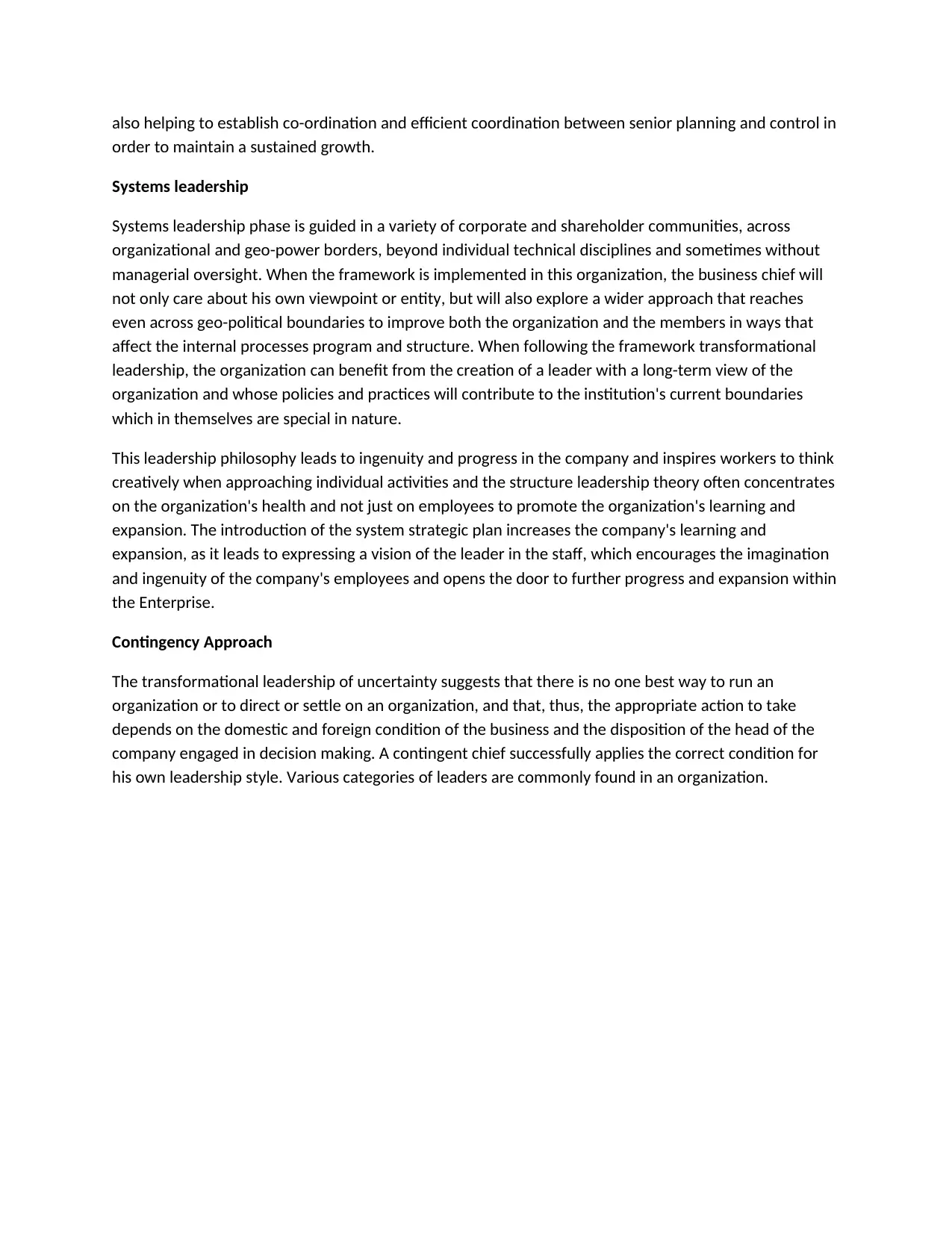
also helping to establish co-ordination and efficient coordination between senior planning and control in
order to maintain a sustained growth.
Systems leadership
Systems leadership phase is guided in a variety of corporate and shareholder communities, across
organizational and geo-power borders, beyond individual technical disciplines and sometimes without
managerial oversight. When the framework is implemented in this organization, the business chief will
not only care about his own viewpoint or entity, but will also explore a wider approach that reaches
even across geo-political boundaries to improve both the organization and the members in ways that
affect the internal processes program and structure. When following the framework transformational
leadership, the organization can benefit from the creation of a leader with a long-term view of the
organization and whose policies and practices will contribute to the institution's current boundaries
which in themselves are special in nature.
This leadership philosophy leads to ingenuity and progress in the company and inspires workers to think
creatively when approaching individual activities and the structure leadership theory often concentrates
on the organization's health and not just on employees to promote the organization's learning and
expansion. The introduction of the system strategic plan increases the company's learning and
expansion, as it leads to expressing a vision of the leader in the staff, which encourages the imagination
and ingenuity of the company's employees and opens the door to further progress and expansion within
the Enterprise.
Contingency Approach
The transformational leadership of uncertainty suggests that there is no one best way to run an
organization or to direct or settle on an organization, and that, thus, the appropriate action to take
depends on the domestic and foreign condition of the business and the disposition of the head of the
company engaged in decision making. A contingent chief successfully applies the correct condition for
his own leadership style. Various categories of leaders are commonly found in an organization.
order to maintain a sustained growth.
Systems leadership
Systems leadership phase is guided in a variety of corporate and shareholder communities, across
organizational and geo-power borders, beyond individual technical disciplines and sometimes without
managerial oversight. When the framework is implemented in this organization, the business chief will
not only care about his own viewpoint or entity, but will also explore a wider approach that reaches
even across geo-political boundaries to improve both the organization and the members in ways that
affect the internal processes program and structure. When following the framework transformational
leadership, the organization can benefit from the creation of a leader with a long-term view of the
organization and whose policies and practices will contribute to the institution's current boundaries
which in themselves are special in nature.
This leadership philosophy leads to ingenuity and progress in the company and inspires workers to think
creatively when approaching individual activities and the structure leadership theory often concentrates
on the organization's health and not just on employees to promote the organization's learning and
expansion. The introduction of the system strategic plan increases the company's learning and
expansion, as it leads to expressing a vision of the leader in the staff, which encourages the imagination
and ingenuity of the company's employees and opens the door to further progress and expansion within
the Enterprise.
Contingency Approach
The transformational leadership of uncertainty suggests that there is no one best way to run an
organization or to direct or settle on an organization, and that, thus, the appropriate action to take
depends on the domestic and foreign condition of the business and the disposition of the head of the
company engaged in decision making. A contingent chief successfully applies the correct condition for
his own leadership style. Various categories of leaders are commonly found in an organization.
⊘ This is a preview!⊘
Do you want full access?
Subscribe today to unlock all pages.

Trusted by 1+ million students worldwide
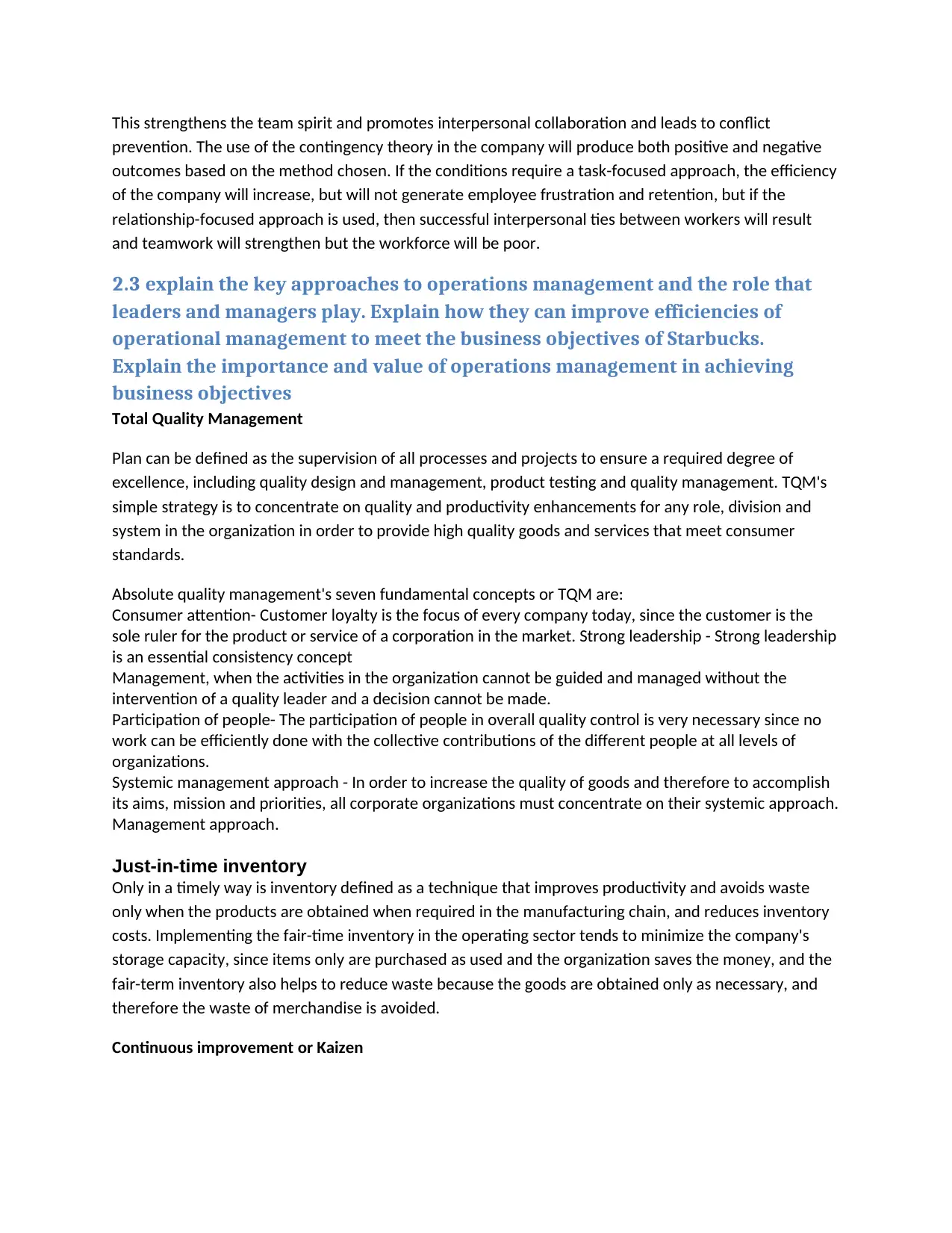
This strengthens the team spirit and promotes interpersonal collaboration and leads to conflict
prevention. The use of the contingency theory in the company will produce both positive and negative
outcomes based on the method chosen. If the conditions require a task-focused approach, the efficiency
of the company will increase, but will not generate employee frustration and retention, but if the
relationship-focused approach is used, then successful interpersonal ties between workers will result
and teamwork will strengthen but the workforce will be poor.
2.3 explain the key approaches to operations management and the role that
leaders and managers play. Explain how they can improve efficiencies of
operational management to meet the business objectives of Starbucks.
Explain the importance and value of operations management in achieving
business objectives
Total Quality Management
Plan can be defined as the supervision of all processes and projects to ensure a required degree of
excellence, including quality design and management, product testing and quality management. TQM's
simple strategy is to concentrate on quality and productivity enhancements for any role, division and
system in the organization in order to provide high quality goods and services that meet consumer
standards.
Absolute quality management's seven fundamental concepts or TQM are:
Consumer attention- Customer loyalty is the focus of every company today, since the customer is the
sole ruler for the product or service of a corporation in the market. Strong leadership - Strong leadership
is an essential consistency concept
Management, when the activities in the organization cannot be guided and managed without the
intervention of a quality leader and a decision cannot be made.
Participation of people- The participation of people in overall quality control is very necessary since no
work can be efficiently done with the collective contributions of the different people at all levels of
organizations.
Systemic management approach - In order to increase the quality of goods and therefore to accomplish
its aims, mission and priorities, all corporate organizations must concentrate on their systemic approach.
Management approach.
Just-in-time inventory
Only in a timely way is inventory defined as a technique that improves productivity and avoids waste
only when the products are obtained when required in the manufacturing chain, and reduces inventory
costs. Implementing the fair-time inventory in the operating sector tends to minimize the company's
storage capacity, since items only are purchased as used and the organization saves the money, and the
fair-term inventory also helps to reduce waste because the goods are obtained only as necessary, and
therefore the waste of merchandise is avoided.
Continuous improvement or Kaizen
prevention. The use of the contingency theory in the company will produce both positive and negative
outcomes based on the method chosen. If the conditions require a task-focused approach, the efficiency
of the company will increase, but will not generate employee frustration and retention, but if the
relationship-focused approach is used, then successful interpersonal ties between workers will result
and teamwork will strengthen but the workforce will be poor.
2.3 explain the key approaches to operations management and the role that
leaders and managers play. Explain how they can improve efficiencies of
operational management to meet the business objectives of Starbucks.
Explain the importance and value of operations management in achieving
business objectives
Total Quality Management
Plan can be defined as the supervision of all processes and projects to ensure a required degree of
excellence, including quality design and management, product testing and quality management. TQM's
simple strategy is to concentrate on quality and productivity enhancements for any role, division and
system in the organization in order to provide high quality goods and services that meet consumer
standards.
Absolute quality management's seven fundamental concepts or TQM are:
Consumer attention- Customer loyalty is the focus of every company today, since the customer is the
sole ruler for the product or service of a corporation in the market. Strong leadership - Strong leadership
is an essential consistency concept
Management, when the activities in the organization cannot be guided and managed without the
intervention of a quality leader and a decision cannot be made.
Participation of people- The participation of people in overall quality control is very necessary since no
work can be efficiently done with the collective contributions of the different people at all levels of
organizations.
Systemic management approach - In order to increase the quality of goods and therefore to accomplish
its aims, mission and priorities, all corporate organizations must concentrate on their systemic approach.
Management approach.
Just-in-time inventory
Only in a timely way is inventory defined as a technique that improves productivity and avoids waste
only when the products are obtained when required in the manufacturing chain, and reduces inventory
costs. Implementing the fair-time inventory in the operating sector tends to minimize the company's
storage capacity, since items only are purchased as used and the organization saves the money, and the
fair-term inventory also helps to reduce waste because the goods are obtained only as necessary, and
therefore the waste of merchandise is avoided.
Continuous improvement or Kaizen
Paraphrase This Document
Need a fresh take? Get an instant paraphrase of this document with our AI Paraphraser
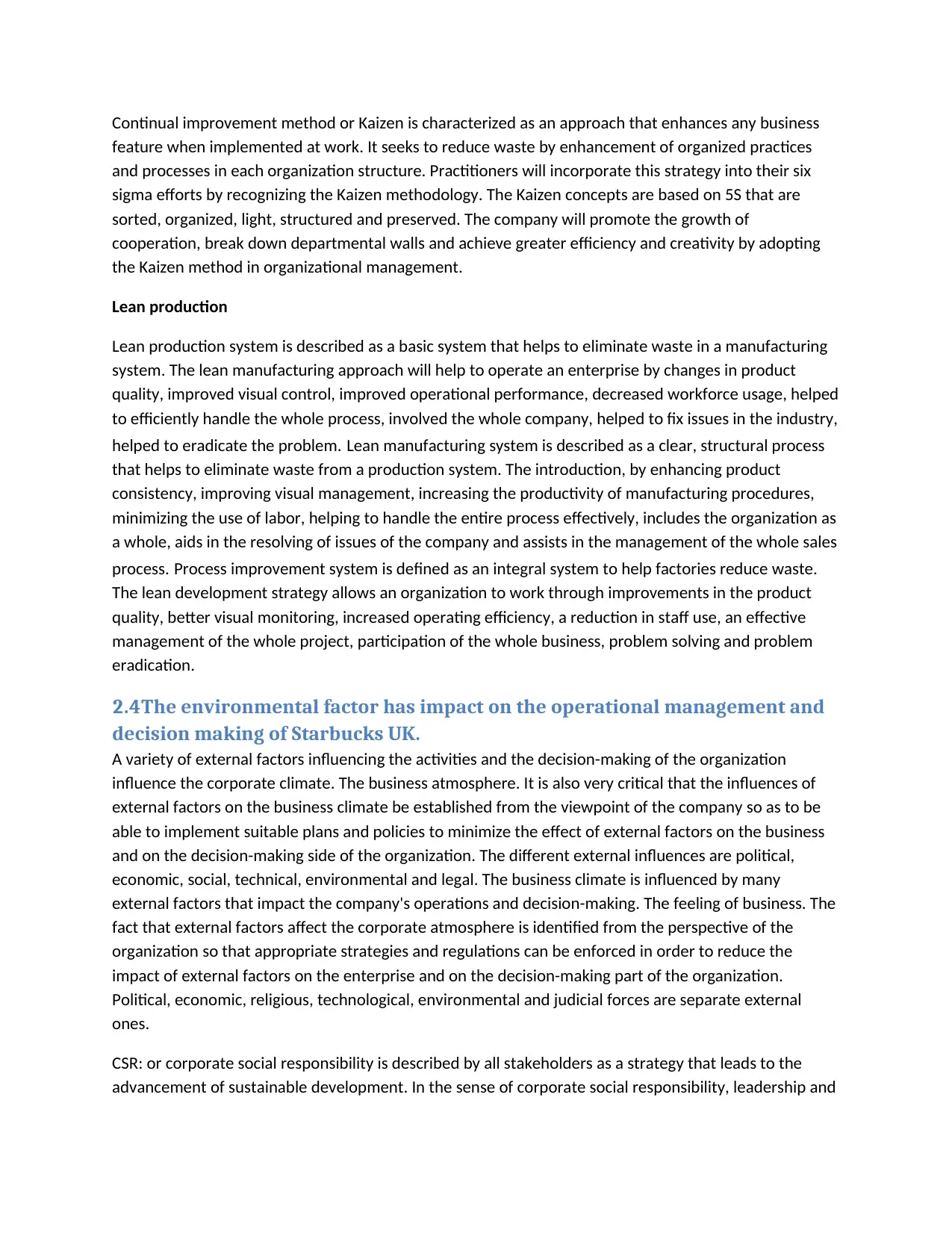
Continual improvement method or Kaizen is characterized as an approach that enhances any business
feature when implemented at work. It seeks to reduce waste by enhancement of organized practices
and processes in each organization structure. Practitioners will incorporate this strategy into their six
sigma efforts by recognizing the Kaizen methodology. The Kaizen concepts are based on 5S that are
sorted, organized, light, structured and preserved. The company will promote the growth of
cooperation, break down departmental walls and achieve greater efficiency and creativity by adopting
the Kaizen method in organizational management.
Lean production
Lean production system is described as a basic system that helps to eliminate waste in a manufacturing
system. The lean manufacturing approach will help to operate an enterprise by changes in product
quality, improved visual control, improved operational performance, decreased workforce usage, helped
to efficiently handle the whole process, involved the whole company, helped to fix issues in the industry,
helped to eradicate the problem. Lean manufacturing system is described as a clear, structural process
that helps to eliminate waste from a production system. The introduction, by enhancing product
consistency, improving visual management, increasing the productivity of manufacturing procedures,
minimizing the use of labor, helping to handle the entire process effectively, includes the organization as
a whole, aids in the resolving of issues of the company and assists in the management of the whole sales
process. Process improvement system is defined as an integral system to help factories reduce waste.
The lean development strategy allows an organization to work through improvements in the product
quality, better visual monitoring, increased operating efficiency, a reduction in staff use, an effective
management of the whole project, participation of the whole business, problem solving and problem
eradication.
2.4The environmental factor has impact on the operational management and
decision making of Starbucks UK.
A variety of external factors influencing the activities and the decision-making of the organization
influence the corporate climate. The business atmosphere. It is also very critical that the influences of
external factors on the business climate be established from the viewpoint of the company so as to be
able to implement suitable plans and policies to minimize the effect of external factors on the business
and on the decision-making side of the organization. The different external influences are political,
economic, social, technical, environmental and legal. The business climate is influenced by many
external factors that impact the company's operations and decision-making. The feeling of business. The
fact that external factors affect the corporate atmosphere is identified from the perspective of the
organization so that appropriate strategies and regulations can be enforced in order to reduce the
impact of external factors on the enterprise and on the decision-making part of the organization.
Political, economic, religious, technological, environmental and judicial forces are separate external
ones.
CSR: or corporate social responsibility is described by all stakeholders as a strategy that leads to the
advancement of sustainable development. In the sense of corporate social responsibility, leadership and
feature when implemented at work. It seeks to reduce waste by enhancement of organized practices
and processes in each organization structure. Practitioners will incorporate this strategy into their six
sigma efforts by recognizing the Kaizen methodology. The Kaizen concepts are based on 5S that are
sorted, organized, light, structured and preserved. The company will promote the growth of
cooperation, break down departmental walls and achieve greater efficiency and creativity by adopting
the Kaizen method in organizational management.
Lean production
Lean production system is described as a basic system that helps to eliminate waste in a manufacturing
system. The lean manufacturing approach will help to operate an enterprise by changes in product
quality, improved visual control, improved operational performance, decreased workforce usage, helped
to efficiently handle the whole process, involved the whole company, helped to fix issues in the industry,
helped to eradicate the problem. Lean manufacturing system is described as a clear, structural process
that helps to eliminate waste from a production system. The introduction, by enhancing product
consistency, improving visual management, increasing the productivity of manufacturing procedures,
minimizing the use of labor, helping to handle the entire process effectively, includes the organization as
a whole, aids in the resolving of issues of the company and assists in the management of the whole sales
process. Process improvement system is defined as an integral system to help factories reduce waste.
The lean development strategy allows an organization to work through improvements in the product
quality, better visual monitoring, increased operating efficiency, a reduction in staff use, an effective
management of the whole project, participation of the whole business, problem solving and problem
eradication.
2.4The environmental factor has impact on the operational management and
decision making of Starbucks UK.
A variety of external factors influencing the activities and the decision-making of the organization
influence the corporate climate. The business atmosphere. It is also very critical that the influences of
external factors on the business climate be established from the viewpoint of the company so as to be
able to implement suitable plans and policies to minimize the effect of external factors on the business
and on the decision-making side of the organization. The different external influences are political,
economic, social, technical, environmental and legal. The business climate is influenced by many
external factors that impact the company's operations and decision-making. The feeling of business. The
fact that external factors affect the corporate atmosphere is identified from the perspective of the
organization so that appropriate strategies and regulations can be enforced in order to reduce the
impact of external factors on the enterprise and on the decision-making part of the organization.
Political, economic, religious, technological, environmental and judicial forces are separate external
ones.
CSR: or corporate social responsibility is described by all stakeholders as a strategy that leads to the
advancement of sustainable development. In the sense of corporate social responsibility, leadership and
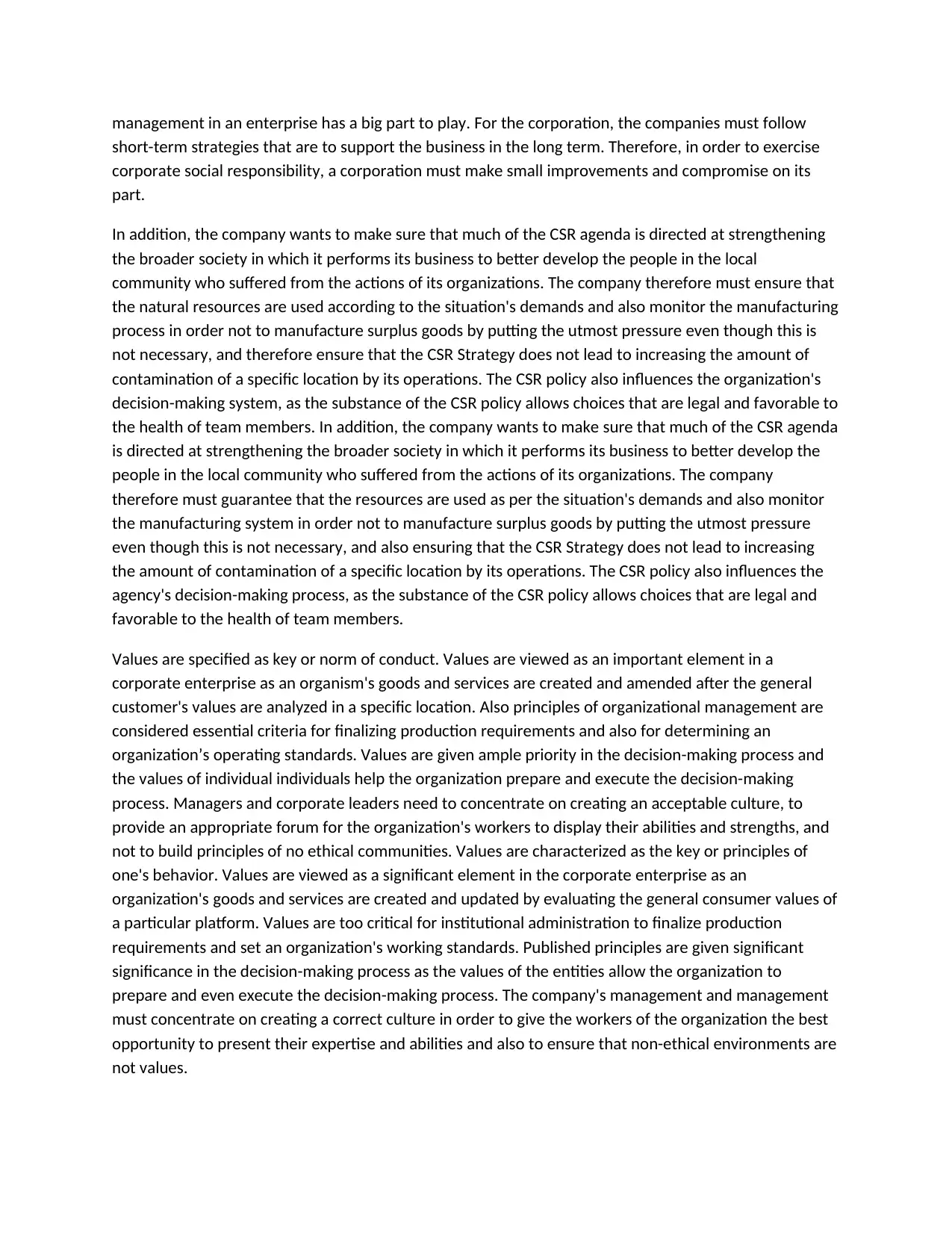
management in an enterprise has a big part to play. For the corporation, the companies must follow
short-term strategies that are to support the business in the long term. Therefore, in order to exercise
corporate social responsibility, a corporation must make small improvements and compromise on its
part.
In addition, the company wants to make sure that much of the CSR agenda is directed at strengthening
the broader society in which it performs its business to better develop the people in the local
community who suffered from the actions of its organizations. The company therefore must ensure that
the natural resources are used according to the situation's demands and also monitor the manufacturing
process in order not to manufacture surplus goods by putting the utmost pressure even though this is
not necessary, and therefore ensure that the CSR Strategy does not lead to increasing the amount of
contamination of a specific location by its operations. The CSR policy also influences the organization's
decision-making system, as the substance of the CSR policy allows choices that are legal and favorable to
the health of team members. In addition, the company wants to make sure that much of the CSR agenda
is directed at strengthening the broader society in which it performs its business to better develop the
people in the local community who suffered from the actions of its organizations. The company
therefore must guarantee that the resources are used as per the situation's demands and also monitor
the manufacturing system in order not to manufacture surplus goods by putting the utmost pressure
even though this is not necessary, and also ensuring that the CSR Strategy does not lead to increasing
the amount of contamination of a specific location by its operations. The CSR policy also influences the
agency's decision-making process, as the substance of the CSR policy allows choices that are legal and
favorable to the health of team members.
Values are specified as key or norm of conduct. Values are viewed as an important element in a
corporate enterprise as an organism's goods and services are created and amended after the general
customer's values are analyzed in a specific location. Also principles of organizational management are
considered essential criteria for finalizing production requirements and also for determining an
organization’s operating standards. Values are given ample priority in the decision-making process and
the values of individual individuals help the organization prepare and execute the decision-making
process. Managers and corporate leaders need to concentrate on creating an acceptable culture, to
provide an appropriate forum for the organization's workers to display their abilities and strengths, and
not to build principles of no ethical communities. Values are characterized as the key or principles of
one's behavior. Values are viewed as a significant element in the corporate enterprise as an
organization's goods and services are created and updated by evaluating the general consumer values of
a particular platform. Values are too critical for institutional administration to finalize production
requirements and set an organization's working standards. Published principles are given significant
significance in the decision-making process as the values of the entities allow the organization to
prepare and even execute the decision-making process. The company's management and management
must concentrate on creating a correct culture in order to give the workers of the organization the best
opportunity to present their expertise and abilities and also to ensure that non-ethical environments are
not values.
short-term strategies that are to support the business in the long term. Therefore, in order to exercise
corporate social responsibility, a corporation must make small improvements and compromise on its
part.
In addition, the company wants to make sure that much of the CSR agenda is directed at strengthening
the broader society in which it performs its business to better develop the people in the local
community who suffered from the actions of its organizations. The company therefore must ensure that
the natural resources are used according to the situation's demands and also monitor the manufacturing
process in order not to manufacture surplus goods by putting the utmost pressure even though this is
not necessary, and therefore ensure that the CSR Strategy does not lead to increasing the amount of
contamination of a specific location by its operations. The CSR policy also influences the organization's
decision-making system, as the substance of the CSR policy allows choices that are legal and favorable to
the health of team members. In addition, the company wants to make sure that much of the CSR agenda
is directed at strengthening the broader society in which it performs its business to better develop the
people in the local community who suffered from the actions of its organizations. The company
therefore must guarantee that the resources are used as per the situation's demands and also monitor
the manufacturing system in order not to manufacture surplus goods by putting the utmost pressure
even though this is not necessary, and also ensuring that the CSR Strategy does not lead to increasing
the amount of contamination of a specific location by its operations. The CSR policy also influences the
agency's decision-making process, as the substance of the CSR policy allows choices that are legal and
favorable to the health of team members.
Values are specified as key or norm of conduct. Values are viewed as an important element in a
corporate enterprise as an organism's goods and services are created and amended after the general
customer's values are analyzed in a specific location. Also principles of organizational management are
considered essential criteria for finalizing production requirements and also for determining an
organization’s operating standards. Values are given ample priority in the decision-making process and
the values of individual individuals help the organization prepare and execute the decision-making
process. Managers and corporate leaders need to concentrate on creating an acceptable culture, to
provide an appropriate forum for the organization's workers to display their abilities and strengths, and
not to build principles of no ethical communities. Values are characterized as the key or principles of
one's behavior. Values are viewed as a significant element in the corporate enterprise as an
organization's goods and services are created and updated by evaluating the general consumer values of
a particular platform. Values are too critical for institutional administration to finalize production
requirements and set an organization's working standards. Published principles are given significant
significance in the decision-making process as the values of the entities allow the organization to
prepare and even execute the decision-making process. The company's management and management
must concentrate on creating a correct culture in order to give the workers of the organization the best
opportunity to present their expertise and abilities and also to ensure that non-ethical environments are
not values.
⊘ This is a preview!⊘
Do you want full access?
Subscribe today to unlock all pages.

Trusted by 1+ million students worldwide
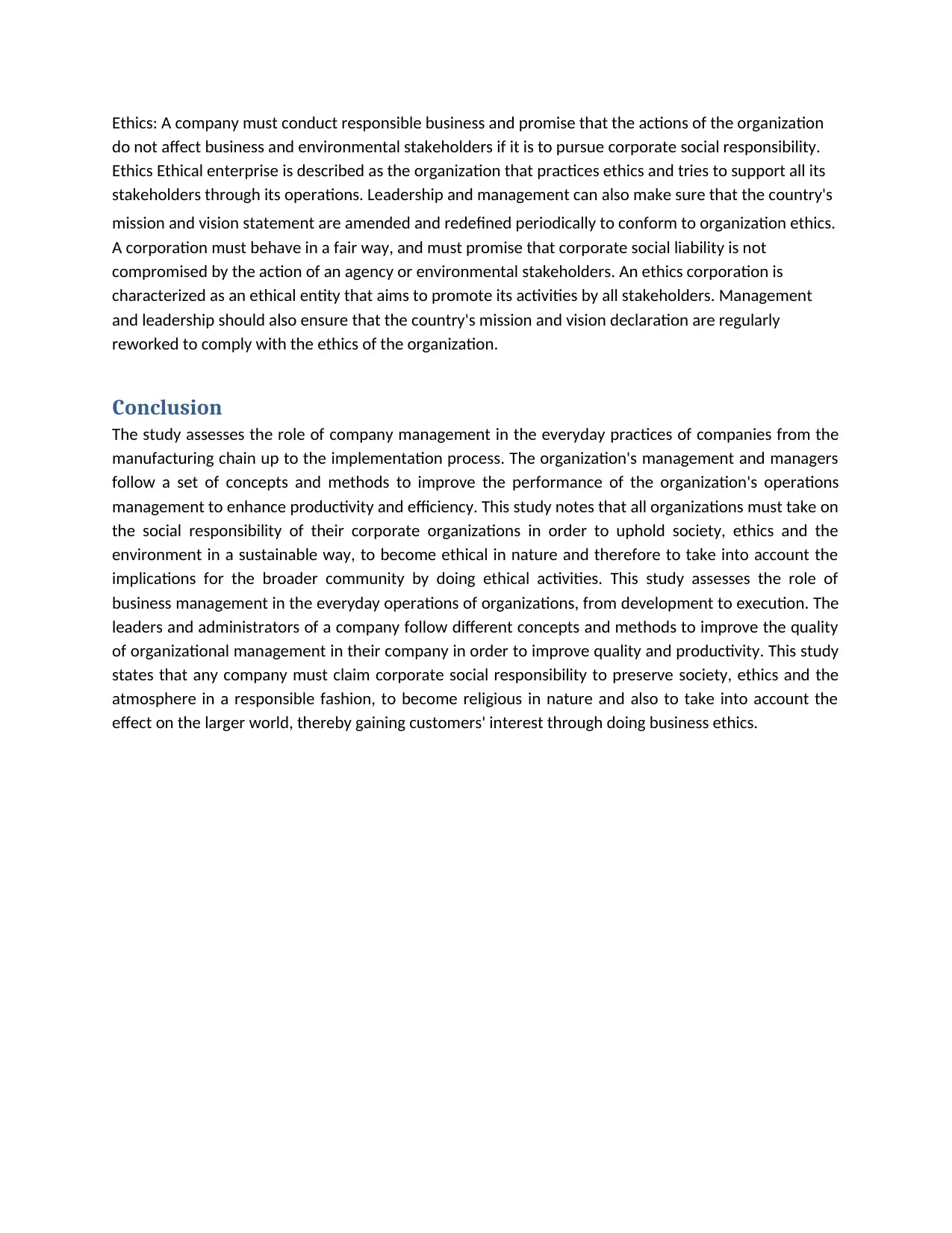
Ethics: A company must conduct responsible business and promise that the actions of the organization
do not affect business and environmental stakeholders if it is to pursue corporate social responsibility.
Ethics Ethical enterprise is described as the organization that practices ethics and tries to support all its
stakeholders through its operations. Leadership and management can also make sure that the country's
mission and vision statement are amended and redefined periodically to conform to organization ethics.
A corporation must behave in a fair way, and must promise that corporate social liability is not
compromised by the action of an agency or environmental stakeholders. An ethics corporation is
characterized as an ethical entity that aims to promote its activities by all stakeholders. Management
and leadership should also ensure that the country's mission and vision declaration are regularly
reworked to comply with the ethics of the organization.
Conclusion
The study assesses the role of company management in the everyday practices of companies from the
manufacturing chain up to the implementation process. The organization's management and managers
follow a set of concepts and methods to improve the performance of the organization's operations
management to enhance productivity and efficiency. This study notes that all organizations must take on
the social responsibility of their corporate organizations in order to uphold society, ethics and the
environment in a sustainable way, to become ethical in nature and therefore to take into account the
implications for the broader community by doing ethical activities. This study assesses the role of
business management in the everyday operations of organizations, from development to execution. The
leaders and administrators of a company follow different concepts and methods to improve the quality
of organizational management in their company in order to improve quality and productivity. This study
states that any company must claim corporate social responsibility to preserve society, ethics and the
atmosphere in a responsible fashion, to become religious in nature and also to take into account the
effect on the larger world, thereby gaining customers' interest through doing business ethics.
do not affect business and environmental stakeholders if it is to pursue corporate social responsibility.
Ethics Ethical enterprise is described as the organization that practices ethics and tries to support all its
stakeholders through its operations. Leadership and management can also make sure that the country's
mission and vision statement are amended and redefined periodically to conform to organization ethics.
A corporation must behave in a fair way, and must promise that corporate social liability is not
compromised by the action of an agency or environmental stakeholders. An ethics corporation is
characterized as an ethical entity that aims to promote its activities by all stakeholders. Management
and leadership should also ensure that the country's mission and vision declaration are regularly
reworked to comply with the ethics of the organization.
Conclusion
The study assesses the role of company management in the everyday practices of companies from the
manufacturing chain up to the implementation process. The organization's management and managers
follow a set of concepts and methods to improve the performance of the organization's operations
management to enhance productivity and efficiency. This study notes that all organizations must take on
the social responsibility of their corporate organizations in order to uphold society, ethics and the
environment in a sustainable way, to become ethical in nature and therefore to take into account the
implications for the broader community by doing ethical activities. This study assesses the role of
business management in the everyday operations of organizations, from development to execution. The
leaders and administrators of a company follow different concepts and methods to improve the quality
of organizational management in their company in order to improve quality and productivity. This study
states that any company must claim corporate social responsibility to preserve society, ethics and the
atmosphere in a responsible fashion, to become religious in nature and also to take into account the
effect on the larger world, thereby gaining customers' interest through doing business ethics.
1 out of 7
Related Documents
Your All-in-One AI-Powered Toolkit for Academic Success.
+13062052269
info@desklib.com
Available 24*7 on WhatsApp / Email
![[object Object]](/_next/static/media/star-bottom.7253800d.svg)
Unlock your academic potential
Copyright © 2020–2025 A2Z Services. All Rights Reserved. Developed and managed by ZUCOL.




